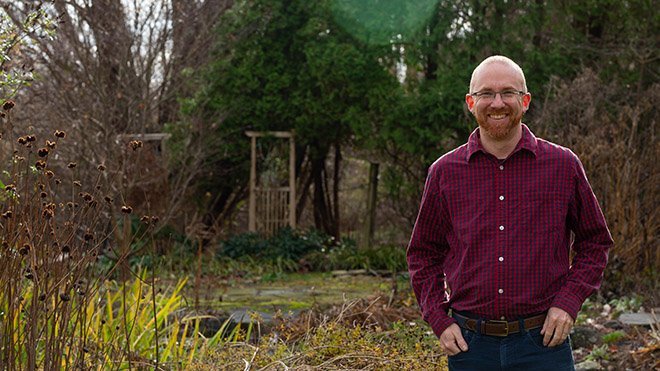RWU Professor Contributes to United Nations' First Global Soil Biodiversity Report
An expert in soil ecology, Loren Byrne shares his research on urbanization and soil management in global study

BRISTOL, R.I. – We may not often think about our dependence on healthy soil, but it’s as critical to us and our planet as clean air and uncontaminated water. Yet, very little research is being done to understand the soil organisms that enrich the earth and how they factor into major environmental threats facing the world.
Roger Williams University Professor Loren Byrne, working as part of a global consortium of researchers, is helping to turn the tide of knowledge through the United Nations' first ever report on soil biodiversity.
Launched today in commemoration of World Soil Day, the U.N. Food and Agriculture Organization (FAO) report on “The State of Knowledge of Soil Biodiversity” explains the crucial role soil organisms play in boosting food production, enhancing nutritious diets, preserving human health, remediating polluted sites and combating climate change. It also covers the status of soil biodiversity across global regions, current management practices and novel approaches that may be employed toward supporting the U.N.’s sustainable development goals.
“Soil biodiversity and sustainable soil management is a prerequisite for the achievement of many of the [United Nations'] Sustainable Development Goals,” said FAO Deputy Director-General Maria Helena Semedo. “Therefore, data and information on soil biodiversity, from the national to the global level, are necessary in order to efficiently plan management strategies on a subject that is still poorly known.”
Byrne, a professor of biology and environmental science at RWU, contributed a chapter to the report on “Urbanization” – the effect of human development on soil biodiversity through construction for homes and industries, from the rise of cities to suburbanization and exurbanization. He investigates how the ecology of the soil changes as it is moved away and compacted from construction, from being paved over, and affected by lawn and garden management.
These factors, he says, not only change soil structural integrity – which helps prevent land erosion, a serious issue for homeowners along the New England coast, and serves as a major contributor to carbon sequestration and the planet’s capacity to combat climate change – but also the ability of living things to inhabit and ultimately nourish the soil. A plethora of creatures, from bacteria to worms, spiders and even mammals live in the ground beneath our feet, fertilizing the soil throughout their lives and afterwards when they are transformed by decomposing organisms into soil nutrients and organic matter.
“Soil is easily overlooked and taken for granted, because it’s everywhere. We walk all over it and think of it as dirt that we can manipulate at our will. But the secret of soil is what’s happening with these soil organisms and what’s happening with their interactions below ground that help regulate our earth’s ecosystems, support life on this planet, regulate carbon and nitrogen cycles, help to control water flow, and provide the medium necessary to grow all our food and forests and gardens and lawns,” said Byrne, a sought-after expert on urban soil ecology. “Additionally, there are a lot of human health connections with soil that soil biodiversity can help prevent, such as pest outbreaks and disease transmission.”
Byrne has authored several publications on soil ecology including author of a chapter on urban soil restoration in the recently published book Soils and Landscape Restoration, and is a longtime member of the Global Soil Biodiversity Initiative (GSBI). On Jan. 21, members of the public can learn more about soil biodiversity issues from Byrne and other scientists who contributed to the United Nation’s global soil report in GSBI’s “First Global Soil Biodiversity Assessment: From Science to Policy.”
In the Roger Williams tradition of bringing real-world research into the classroom, Byrne provided students in his soil ecology course an early look at his work for the U.N. report and they held discussions around urbanization and soil biodiversity.
“My goal is to connect their learning to this global effort, so they see the growing global awareness of these important issues and help them feel that connection to the larger story of why people should care about soil ecology,” Byrne said. “At RWU, we train them to think like scientists from day one and to learn to collaborate as researchers.”
The comprehensive report will be shared with policy makers around the world to help inform policies and actions on soil biodiversity, as well as raise awareness of the critical role soil management plays in shaping our future.